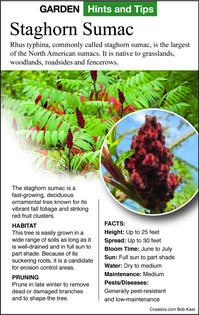The Greener View: Sumac and Yew
Q: My sumac (staghorn) is now sprouting many "little sumacs" everywhere. I have been trying to pull them up (seldom being able to get the root), but they are popping up faster than I can pull them. I guess the term is called colonizing! Can anything be sprayed on the babies that will kill only them? I'm afraid that chemicals would travel to the main tree. Any suggestions?
A: I am afraid you are in trouble. You are right: Sumac plants form colonies, and spraying parts of the colony can kill portions of it that you want to keep. These plants are aggressive enough to come up a long way away from the original plant. Being aggressive can be good on steep slopes or roadsides, but it can be hard to keep up with in a garden. Some individual sumac plants in some individual locations are hardly aggressive at all, but it sounds like yours isn't one of them. Cutting the little sumacs off repeatedly is the best way of preventing them from getting a foothold in a new location.
If you really like the plant in a particular location and can find a trencher at a rental location, you can dig a trench around the plant. Go down at least 12-18 inches. Drop a piece of stiff plastic or thin exterior treated plywood in the trench to form a wall. This will slow the spread of the roots to a controllable rate. Then, spray all the other locations the sumac has popped up around the yard.
Q: Could you please help me with my Capitata yew problem? I have noticed that other people seem to have the same problem. My four corner yews are probably 6 feet tall and have been in place for 10 years or so. They were filled out beautifully previously, but lately, the needles are getting thinner. I shear them back to a pyramid shape each June, then trim them later if they need it. The new growth wants to come in heavily at the top of the plant and not lower down.
A: The biggest problem with all shrubs that are tightly pruned to the same size and shape is that new growth does not get a chance to mature. Even though many plants are very tolerant of repeated pruning, they still need to expand in size a little bit each year. Evergreen branches are not permanently green. The needles will stay on their stem until that stem matures and expands in size. A few years down the road, the branch will be larger and then the needles will fall off.
A large mature branch has no needles of its own. Instead, it supports smaller side branches that have their own needles. If a plant is kept the same size over a period of years, the small side branches are being cut off and all that is left is the old mature branch that isn't capable of having needles. If the plant is allowed to expand in size a little bit each year, the new branches with their needles will stay on the plant and it will look nicer.
In your case, most of the new growth is occurring at the top of the plant, not at the bottom. Try letting the surviving new growth that is lower on the plant expand the plant size by an inch or two each of the next couple of years to see if the vacant space can be filled in.
Another common problem when hedges thin out is that sunlight cannot reach the bottom branches if the plant is pruned wider at the top than at the bottom. A properly pruned hedge will be an inch or two wider at the bottom for every few feet in height (6 feet high equals 6 to 12 inches wider at the base). Since your yew is pruned into a pyramid shape, that is not going to be the problem, but look to see if other shrubs are shading the bottom of the yew.
========
Email questions to Jeff Rugg at info@greenerview.com. To find out more about Jeff Rugg and read features by other Creators Syndicate writers and cartoonists, visit the Creators Syndicate website at www.creators.com.
Copyright 2025 Jeff Rugg. Distributed By Creators.








Comments